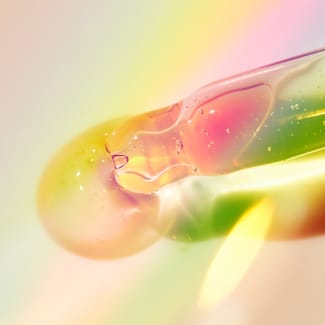Data: Good
Octocrylene
- Products with this ingredient are allowed for use in EWG VERIFIED but must meet use restrictions and warnings based on EWG review of company data.
- This ingredient's score is higher if there is potential contamination from toxic impurities. The score will be lower if used in products that meet EWG’s contamination restrictions.
Other Concerns
Persistence and bioaccumulation (low_moderate), Ecotoxicology (low), Irritation (skin, eyes, or lungs) (low), Contamination concerns (high), and Biochemical or cellular level changes (high)SYNONYMS
Restricted
Restricted: EWG VERIFIED products cannot contain this ingredient without adequate substantiation
Octocrylene is a synthetic UV absorber and sunscreen agent; may be used in combination with other UV absorbers to achieve higher SPF formulas. It produces oxygen radicals when exposed to UV light.
Common concerns
See how this product scores for common concerns.
-
LOWCancer
-
LOW_MODERATEAllergies & Immunotoxicity
-
LOWDevelopmental and Reproductive Toxicity
-
LOWUse Restrictions
Ingredient concerns
- CONCERNS
- DATA SOURCES
Products with this Ingredient


| conditioner | 5 products |
| body spray | 33 products |
| fragrance for women | 46 products |
| facial powder | 1 products |
| shampoo | 5 products |
| lip balm | 18 products |
| recreational sunscreen | 545 products |
| lip gloss | 54 products |
| facial moisturizer/treatment | 31 products |
| lipstick | 16 products |
| daily use with SPF | 332 products |
| after shave | 1 products |
| lip balm with SPF | 64 products |
| tanning oil | 10 products |
| baby sunscreen | 52 products |
| makeup primer | 9 products |
| fragrance for men | 3 products |
| anti-aging | 5 products |
| nail polish | 102 products |
| moisturizer | 8 products |
| foundation | 57 products |
| setting powder/spray | 5 products |
| concealer | 3 products |
| body firming lotion | 6 products |
| damaged skin treatment | 2 products |
| bronzer/highlighter | 1 products |
| body wash/cleanser | 1 products |
| sunless tanning | 18 products |
| Facial Sun Care | 23 products |
| blush | 19 products |
| CC cream | 44 products |
| liquid hand soap | 5 products |
| hand cream | 2 products |
| BB cream | 4 products |
| body oil | 6 products |
| around-eye cream | 1 products |
| serums & essences | 7 products |
| hair styling aid | 2 products |
| hair spray | 2 products |
| hair treatment/serum | 8 products |
| nail treatment | 1 products |
Contamination concerns


| Chemical |
|---|
| BENZOPHENONE |
Biochemical or cellular level changes


| CONCERN | REFERENCE |
|---|---|
| Produces excess reactive oxygen species that can interfere with cellular signaling, cause mutations, lead to cell death and may be implicated in cardiovascular disease. | Photochemical formation of singlet molecular oxygen in illuminated aqueous solutions of several commercially available sunscreen active ingredients(1996-04-01) |
| Produces excess reactive oxygen species that can interfere with cellular signaling, cause mutations, lead to cell death and may be implicated in cardiovascular disease. | Sunscreen enhancement of UV-induced reactive oxygen species in the skin(2006-10-15) |
Enhanced skin absorption


| CONCERN | REFERENCE |
|---|---|
| Absorbs into the skin | The stripping technique: in vitro absorption and penetration of five UV filters on excised fresh human skin(2000-11-01) |
| Absorbs into the skin | Sunscreen penetration of human skin and related keratinocyte toxicity after topical application(2005-07-01) |
| Absorbs into the skin | Effect of Sunscreen Application on Plasma Concentration of Sunscreen Active Ingredients: A Randomized Clinical Trial(2020-01-01) |
Decreased skin absorption


| CONCERN | REFERENCE |
|---|---|
| Limited potential to absorb into the skin. | Sunscreen penetration of human skin and related keratinocyte toxicity after topical application(2005-07-01) |
Ecotoxicology


| CONCERN | REFERENCE |
|---|---|
| Wildlife and environmental toxicity | Occurrence of UV filters 4-methylbenzylidene camphor and octocrylene in fish from various Swiss rivers with inputs from wastewater treatment plants(2006-03-01) |
| Suspected to be an environmental toxin | Metabolomics Reveal That Octocrylene Accumulates in Pocillopora damicornis Tissues as Fatty Acid Conjugates and Triggers Coral Cell Mitochondrial Dysfunction(2019-01-01) |
| Not suspected to be an environmental toxin | Environment Canada |
Persistence and bioaccumulation


| CONCERN | REFERENCE |
|---|---|
| Found to be persistent and bioaccumulative in wildlife | Occurrence of UV filters 4-methylbenzylidene camphor and octocrylene in fish from various Swiss rivers with inputs from wastewater treatment plants(2006-03-01) |
| Not suspected to be persistent | Environment Canada |
| Ingredient is suspected or measured to accumulate in people | Peer Reviewed Literature |
Allergies/immunotoxicity


| CONCERN | REFERENCE |
|---|---|
| One or more human case studies show possible or allergenic effects | Contact and photocontact allergy to octocrylene: a review(2014-04-01) |
Organ system toxicity (non-reproductive)


| CONCERN | REFERENCE |
|---|---|
| Classified as not expected to be potentially toxic or harmful | Environment Canada |
Irritation (skin, eyes, or lungs)


| CONCERN | REFERENCE |
|---|---|
| Limited evidence of [[system]] irritation | Peer Reviewed Literature |
- Photochemical formation of singlet molecular oxygen in illuminated aqueous solutions of several commercially available sunscreen active ingredients(1996-04-01)
- Sunscreen enhancement of UV-induced reactive oxygen species in the skin(2006-10-15)
- The stripping technique: in vitro absorption and penetration of five UV filters on excised fresh human skin(2000-11-01)
- Sunscreen penetration of human skin and related keratinocyte toxicity after topical application(2005-07-01)
- Effect of Sunscreen Application on Plasma Concentration of Sunscreen Active Ingredients: A Randomized Clinical Trial(2020-01-01)
- Occurrence of UV filters 4-methylbenzylidene camphor and octocrylene in fish from various Swiss rivers with inputs from wastewater treatment plants(2006-03-01)
- Metabolomics Reveal That Octocrylene Accumulates in Pocillopora damicornis Tissues as Fatty Acid Conjugates and Triggers Coral Cell Mitochondrial Dysfunction(2019-01-01)
- Environment Canada
- Peer Reviewed Literature
- Contact and photocontact allergy to octocrylene: a review(2014-04-01)
Understanding scores
Cosmetics and personal care products are not required to be tested for safety before being allowed on the market. The Skin Deep® scoring system was designed to help the public understand whether a product is safe to use or whether it contains ingredients of concern.
Every product and ingredient in Skin Deep gets a two-part score – one for hazard and one for data availability. The safest products score well by both measures, with a low hazard rating and a fair or better data availability rating.
HOW WE DETERMINE SCORES
Hazard score
The Skin Deep ingredient hazard score, from 1 to 10, reflects known and suspected hazards linked to the ingredients. The EWG Verified® mark means a product meets EWG’s strictest criteria for transparency and health.
Data availability
The Skin Deep data availability rating reflects the number of scientific studies about the product or ingredient in the published scientific literature.











